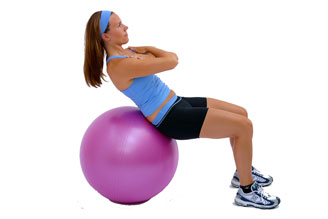The Swiss Exercise Ball
What is an Exercise Ball?
Exercise balls are large, heavy-duty inflatable balls with a diameter of 45 to 75 cm (18 to 30 inches).
All TheraGear® Balls have two weight ratings:
- Burst-proof limit or TheraGuard™ System: This will ensure that the exercise ball will not explode but deflate slowly if it is accidentally punctured. They are generally rated to hold between 200lb - 500lb
- Weight Limit: Static weight that can be put on the ball, generally between 600lb - 2200lb

The exercise ball is also known by a number of different names, including Swiss ball, gym ball, Pilate's ball, sports ball, fit or fitness ball, stability ball, therapy ball, yoga ball, balance ball, body ball, or birth ball.
Exercise balls offer you a fun, safe and highly effective way to exercise. They will last for a very long time and are inexpensive compared to other exercise equipment.
Where did they come from?
Exercise balls were originally used in rehabilitation. Physical
therapist and chiropractors in Switzerland
used the exercise or therapy ball 30 years ago. In 1989, a physical therapist
named Joanne Posner-Mayer began instructing US therapists on the neurological,
orthopedic and fitness applications of the Swiss Ball. Today, athletic
trainers, strength coaches, personal trainers and physical therapists use the
Swiss Ball in their fitness and rehab programs, which they have designed for
their athletes, patients and the general fitness population.
Why should I use an Exercise Ball?
Exercise balls are one of today's top fitness tools - and for good reason! Using an exercise ball will improve the strength of the abs and the lower back. Since the exercise ball is unstable you have to constantly adjust your balance, which in turn will improve your balance, proprioception and flexibility. As an extra challenge you can use the exercise ball as a bench using free-weights to target those hard to reach stabilizer muscles.
1.
Proper Alignment
Using the exercise ball during training will utilize
many additional muscles to maintain stability and balance. Exercise balls are less stable than
traditional fitness
equipment, which can greatly improve your balance, coordination and core
strength. The alignment of your body is also improved when proper balance is
maintained.
2.
Great Abs
An abdominal crunch on the
fitness ball has been scientifically proven to work your abs better than a
regular crunch. For people working out to achieve
great abs, the exercise ball can definitely target the abdominal areas as the
abs and back muscles are simultaneously worked.
3.
Muscle Strength and Endurance
The exercise ball can
improve muscle strength and endurance in all of the major muscle groups. Training
with the stability ball can help in alleviating back pain and preventing pain
in the future. As all the major muscle groups are exercised, tone, strength and
endurance are improved as well as flexibility and balance.
4.
Core Stability
Exercise balls are less stable than traditional fitness equipment so you can
also greatly improve your balance, coordination and core strength in your abs
and back. The major muscles that help
stabilize and support all of your body movements are made up of the back and
the deep abdominal muscles. With the exercise ball no matter how "deep" these
muscles are, they are still exercised. This is something only the ball can
guarantee.
5. Stretching
The exercise ball is a great tool for stretching
exercises. With this, you can easily move into and move out of different
stretching positions. Training with the exercise ball will restore or improve
your flexibility.
6. Losing Weight
Any exercise that strengthens your muscles will help
to reduce body fat. With regular exercise using the stability ball, you will
also lose weight
What type of ball should I be using?
We recommend TheraGuard™ System balls because this technology guarantees the highest standard of safety and quality.
Swiss exercise balls are made with a special material that prevents the ball from dangerously exploding if accidentally
punctured. Acrylic particles allow air to release gradually so TheraGuard™ System balls deflate slowly - and safely. (Provided TheraGuard™ System limits are not
exceeded).
The materials we use are very resistant to wear and tear, even when you use them with heavy weights. Even though TheraGuard™ System balls don't burst, you can increase the life of your ball and reduce your risk of injury by keeping the ball away from sharp objects and surfaces.
| Exercise Ball Type | Swiss Aero Ball | Swiss Exercise Ball | Swiss Exercise Ball (Pro Grade) |
|---|---|---|---|
| Description | Ideal for Aerobic, Yoga & Stretching. Our softest and bounciest ball | Great for core, resistance training & rehabilitation. This ball offers firm support | Ideal for weight training.� Extra firm ball endures your toughest workout |
| Static Weight Limit | 1100 lbs | 1500 lbs | 2200 lbs |
| TheraGuard™ System - | 200 lbs | 300 lbs | 500 lbs |
| Burst Proof |
How to determine the correct exercise ball size:
| Swiss Exercise Balls | |
|---|---|
| Body Height | Ball Size |
| Up to 4'10", 145cm | 18"/45cm |
| 4'8" to 5'5", 146-165cm | 22"/55cm |
| 5'6" to 6'0", 166-185cm | 26"/65cm |
| 6'0" to 6'5", 186-195cm | 30"/75cm |
This chart is only a guideline. The final test for ball size is determined when you sit on the exercise ball. Your buttocks should be supported by the ball at a level at or above your knee height.
